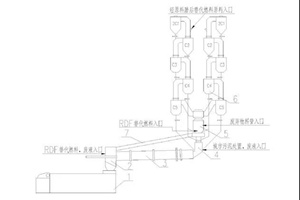According to on-site investigations, the damage of refractory materials is mainly concentrated in the main area of the rotary kiln. Hazardous waste incineration mainly includes the following typical treatment processes. In view of this, the following design optimization suggestions are proposed.
1) Handling of materials with high moisture content
The material entering the kiln has a high moisture content, and the refractory at the feed end is severely thermally peeled off. Refractory materials such as mullite, corundum mullite, corundum silicon carbide with good thermal shock stability are suitable for this area.
2) Large amount of kiln waste liquid treatment and poor atomization
Generally, the kiln head uses an atomizing gun to treat the waste liquid. The incineration area is mainly in the drying section. If the atomization effect is not good due to the influence of the equipment, the refractory materials in this area will also be peeled and damaged, such as mullite, corundum, mullite, Corundum silicon carbide materials are also suitable for this. During operation, it is generally necessary to increase the frequency of checking the atomization equipment, and the waste liquid treatment volume should not exceed 30%.
3) Large processing capacity of hard materials such as iron sheets (barrels)
Iron barrels and other materials have high hardness, slow rotation of the rotary kiln, and repeated rotation of the materials in the kiln cause serious mechanical wear in the feeding area. Choosing corundum silicon carbide refractories with high strength and better wear resistance has good results.
4) Materials with high content of low melting point salt
When the material contains more than 5% K and Na salt, the melting point is lower, and high-temperature slag is easily formed, which can penetrate and corrode the refractory material seriously. When high-temperature slag appears, it is more appropriate to choose chromium-zirconium corundum as refractory material in high-temperature zone. Generally, the content of Cr2O3 ranges from 3 to 10%.
5) Materials with high fluorine content
The proportion of fluorine in the material is relatively high, reaching 1~4%, as shown in formula (1), because F and Si in the refractory material easily react to form SiF4 gasification, causing damage to the lining matrix structure and rapid erosion; strict control is required The impurity content in the refractory materials, especially the silicon dioxide content, is made of chromium corundum material with a Cr2O3 content of 9-15%, which can meet the needs of the normal operation of the rotary kiln.
SiO2 + 4HF = SiF4↑ + 2H2O (1)
- Concluding remarks
Hazardous waste incineration is an emerging field. Among them, there are many types of hazardous waste, with large differences in physical properties and calorific value. Rotary kilns and secondary combustion chamber linings are designed in various forms according to needs. With the country’s increased supervision of hazardous waste, large-scale rotary kiln incineration technology will be more widely used in hazardous waste treatment, which poses a challenge to the selection and design of refractory materials for rotary kiln incinerators. Compared with traditional high-temperature kilns, refractory researchers should pay more attention to the characteristics of hazardous waste materials, working conditions (incineration temperature, flue gas composition), etc.

